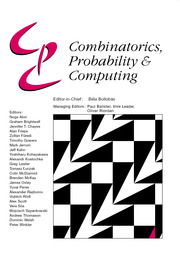Crossref Citations
This article has been cited by the following publications. This list is generated based on data provided by
Crossref.
Aiello, William
Chung, Fan
and
Lu, Linyuan
2000.
A random graph model for massive graphs.
p.
171.
Callaway, Duncan S.
Newman, M. E. J.
Strogatz, Steven H.
and
Watts, Duncan J.
2000.
Network Robustness and Fragility: Percolation on Random Graphs.
Physical Review Letters,
Vol. 85,
Issue. 25,
p.
5468.
Krapivsky, P. L.
and
Redner, S.
2001.
Organization of growing random networks.
Physical Review E,
Vol. 63,
Issue. 6,
Newman, M. E. J.
2001.
Scientific collaboration networks. I. Network construction and fundamental results.
Physical Review E,
Vol. 64,
Issue. 1,
Dorogovtsev, S. N.
Mendes, J. F. F.
and
Samukhin, A. N.
2001.
Anomalous percolation properties of growing networks.
Physical Review E,
Vol. 64,
Issue. 6,
Aiello, William
Chung, Fan
and
Lu, Linyuan
2001.
A Random Graph Model for Power Law Graphs.
Experimental Mathematics,
Vol. 10,
Issue. 1,
p.
53.
Aiello, W.
Fan Chung
and
Linyuan Lu
2001.
Random evolution in massive graphs.
p.
510.
Callaway, Duncan S.
Hopcroft, John E.
Kleinberg, Jon M.
Newman, M. E. J.
and
Strogatz, Steven H.
2001.
Are randomly grown graphs really random?.
Physical Review E,
Vol. 64,
Issue. 4,
Burda, Z.
Correia, J. D.
and
Krzywicki, A.
2001.
Statistical ensemble of scale-free random graphs.
Physical Review E,
Vol. 64,
Issue. 4,
Newman, M. E. J.
2001.
Scientific collaboration networks. II. Shortest paths, weighted networks, and centrality.
Physical Review E,
Vol. 64,
Issue. 1,
Strogatz, Steven H.
2001.
Exploring complex networks.
Nature,
Vol. 410,
Issue. 6825,
p.
268.
Sorkin, Gregory B.
2001.
Stochastic Algorithms: Foundations and Applications.
Vol. 2264,
Issue. ,
p.
117.
Dorogovtsev, S. N.
Mendes, J. F. F.
and
Samukhin, A. N.
2001.
Giant strongly connected component of directed networks.
Physical Review E,
Vol. 64,
Issue. 2,
Cohen, Reuven
Erez, Keren
ben-Avraham, Daniel
and
Havlin, Shlomo
2001.
Breakdown of the Internet under Intentional Attack.
Physical Review Letters,
Vol. 86,
Issue. 16,
p.
3682.
Newman, M. E. J.
Strogatz, S. H.
and
Watts, D. J.
2001.
Random graphs with arbitrary degree distributions and their applications.
Physical Review E,
Vol. 64,
Issue. 2,
Newman, M. E. J.
Watts, D. J.
and
Strogatz, S. H.
2002.
Random graph models of social networks.
Proceedings of the National Academy of Sciences,
Vol. 99,
Issue. suppl_1,
p.
2566.
Dorogovtsev, S. N.
Goltsev, A. V.
and
Mendes, J. F. F.
2002.
Ising model on networks with an arbitrary distribution of connections.
Physical Review E,
Vol. 66,
Issue. 1,
Krapivsky, P.L.
and
Redner, S.
2002.
A statistical physics perspective on Web growth.
Computer Networks,
Vol. 39,
Issue. 3,
p.
261.
Chung, Fan
and
Lu, Linyuan
2002.
The average distances in random graphs with given expected degrees.
Proceedings of the National Academy of Sciences,
Vol. 99,
Issue. 25,
p.
15879.
Söderberg, Bo
2002.
General formalism for inhomogeneous random graphs.
Physical Review E,
Vol. 66,
Issue. 6,

